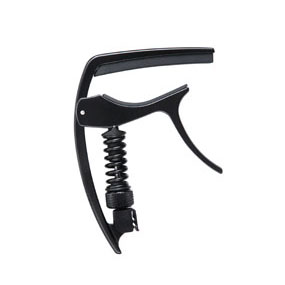“Standard” tuning allows you to easily play in every key using recognizable scales, patterns, and shapes, but it’s not the only way to go. Besides, barre chords hurt like hell and open strings will always sound better than fretted ones. They simply have more sustain, clarity, and overtones. I was a frustrated guitarist before I started tuning differently. Alternate tunings taught me to trust my ear and exploit the guitar’s full potential as a solo instrument. I’m going to go over a few fun tunings that have the potential to inspire.
DADGAD: My standard. You get a surprising amount of versatility with this one. Call it “modal,” call it a Sus4, or call it “moody.” It’s only a half step away from a major D chord, but you can go from major folk to minor blues to modal Celtic to eastern-sounding harmonic minor in a flash. You can also play most open chords in the first position if you’re wiling to stretch and sacrifice the occasional third. Then, after you master the basic chord shapes, you can play along with your friends without sounding redundant. Better bring a capo, though!
More than anything else, this tuning allows for some serious droning. Snap that low D with your thumb and have fun exploring the fretboard. With a little practice, you’ll fool people into thinking you’re more than one person. Unfortunately, that’s not always a good thing. I was once dropped from a bill because they had listened to my recordings and thought I was a band…
Open D/Open E (DADF#AD / EBEG#BE). Great for slide. Open E especially will raise the strings up off the fretboard high enough for you to really cut in without knocking any frets. There are also a handful of great “pedal chord”* shapes that fall right into your lap. Open D is used a lot in old country blues. My favorite instrumental of all time, “Dark Was the Night, Cold Was the Ground,” by Mr. Blind Willie Johnson, is in Open D.
Open D/E Minor (DADFAD / EBEGBE): Drop that third and get spooky!
Open E 6th ( E B E G# C# E) : Relax! Get tropical! A friend of mine once described this tuning as “instant George Harrison.”
CACGAD: Whoa! Want your guitar to sound like a piano? This is my new favorite.
Open G: Great versatility for slide. Also good for banjo pickers.
In summary, you don’t have to be Sonic Youth or Skip James to enjoy alternate tunings. Nor do you have to understand every theoretical nuance behind what you’re doing. Just trust your ear and try and think emotionally rather than technically. It’s not for everyone, but it’s a lot of fun.
*A chord shape that can be slid up/down two frets or more and not sound terrible.
-Robinson Lee Earle


